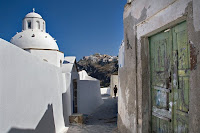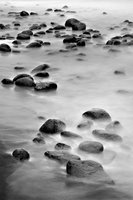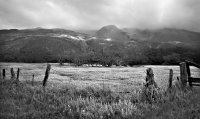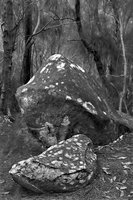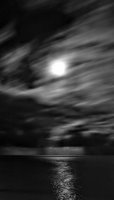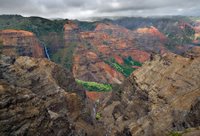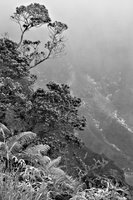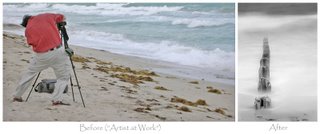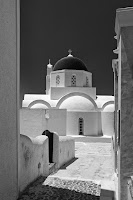
In my last post, and immediately on the heels of returning from a trip my wife and I took to Greece, I noted that Santorini = geometry + color + shadow; emphasizing color, in particular, and brazenly declaring that Santorini is glorious, breathing, living, and sometimes blindingly bright color.
While I do not back down from those words - indeed, as I look over my growing portfolio of finished images and a selection of draft prints, I am, if anything, even more enamored of the "full color" results - an interesting thing happened as I went back (a second time) to process a few images in black and white: they reminded me of how awestruck I was when I first gazed onto the strange Escher-like Santorini architecture.
To be sure, what struck my eye first (or so I remember) was Santorini's blazing color; and my first emotion was pure joy - joy at being on a long awaited and much needed vacation with my lovely wife, joy at finally arriving at such a magnificently beautiful place, and joy at looking forward to discovering yet-unseen but sure to be wondrous sites. Consequently, when we got back home and I started processing my images in my usual style, I was struck by how much of my raw joy was missing from the black and white images. However, the color images instantly evoked many of the same feelings. My earlier blog entry thus followed naturally.
So what happened afterwards, and what is the point of this new entry? The answer is both "simple" and subtle...and, for me, a source of an important lesson I ought to have learned long ago. After working on over a 100 or so color images, and taking a few days "off" (while working on other, much older images having nothing to do with Santorini or Greece), I went back for a second look at my Greece files. I must emphasize that as I managed my usual black and white workflow, I did nothing objectively different from what I had originally done upon our arrival home from Greece (and what had originally resulted in my decidedly negative reaction, compelling me to work in color). But this time, even after completing only the first few files, I was struck by how powerfully the black and white images reminded me of the unbridled awe I felt at simply being in Santorini and finding myself amidst its magnificent architecture. This awe was not, strictly speaking, an emotional awe; it was much more akin an intellectual awe. My experience of witnessing Santorini's architectural splendor unfolding before me reminds me of the first time I gazed at an Escher print (which eventually resulted in a lifelong pursuit of math and physics). The point is that I had (at least) two layers of experience with Santorini landscapes; and that both cannot be simultaneously expressed equally as strongly in a single type of image. While the color images most strongly evoke the purely emotional side of my experience, the black and white images most strongly evoke the purely intellectual and cognitive side of my experience. Interestingly, neither type of image - alone - suffices to express the full depth of my experience. (This vaguely reminds me of Heisenberg's uncertainty relation between complementary variables, such as position and momentum, on the atomic scale).
Why had I not noticed this the first time around? I think it is because my emotion - or, rather, my strong desire to express my emotion of being in Santorini - was so overwhelming, that the secondary component of my experience in Santorini (a somewhat more detached intellectual "awe" of its geometry) was lost in the process. Yes, the color images vivdly convey the blazing light and glorious color of the island; but they also leave little room for any reaction other than a joyful exhuberance. The focus on color in my color images is necessarily so strong, and so dominant, that even the photographer's own eye is unable to discern the other - equally as important - dimensions of the original experience. In a sense, going back to the original files and "revisioning" them in black and white (although, truth be told, that is how I originally "saw" them while I was composing; I chose to retain the color afterwards only because the color reminded me of what I felt in Santorini, not because that is how I previsualized the images taken there) is my answer to Minor White's well-known admonition to use photography to tell the viewer something about what else the subject matter is. My color images show you what Santorini is; my black and white images tell you what else it is.
By stripping away the color, by focusing exclusively on only two of the three dimensions - geometry and shadow - I can more easily express the emotionally less charged component of my experience. Since color is absent, it is no longer the "distraction" it is in the color versions of the same images. The viewer is forced to interpret an image in terms of form and tone alone; and, hence, in Santorini's case, in terms of geometry and shadow.
And as for my lesson...? The lesson - I warn you it is a "trivial" one, but one I obviously needed to "relearn" at best - is that a single image can be used to express markedly different emotions; the "emotion" being a function of how the original captured (or raw) image is processed. Indeed, since my experience of Santorini (as of any place I visit, including places I know as well as my own backyard) is obviously multidimensional and is far deeper than "mere" joy and awe, I suspect that I will slowly discover multiple versions of the same underlying "raw" image captured by the camera. Collectively, and over time, these "expressions" will tell an increasingly more refined (but forever incomplete) story of my experience in Santorini. And I will continue to search for ways to bring out (and discover!) certain aspects of my original experience; undoubtedly focusing on one particular dimension at a time, at the expense of another, complimentary one (perhaps best expressed by some other expression; or "performance", as Ansel Adams likened a print to a negative). But, of course, that is precisely what photography is supposed to be all about :-) (Shows how much I have left to learn!)

